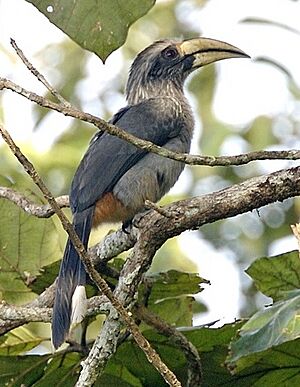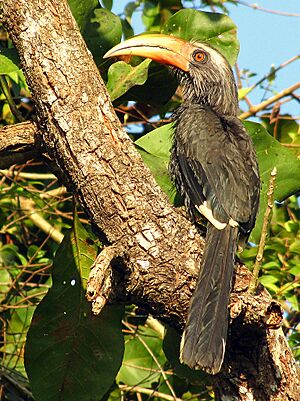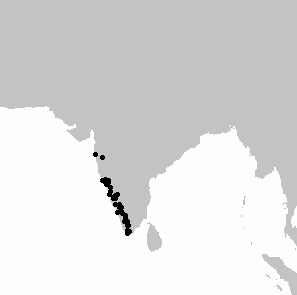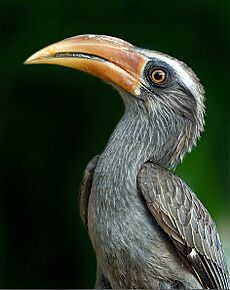Malabar grey hornbill facts for kids
Quick facts for kids Malabar grey hornbill |
|
|---|---|
 |
|
 |
|
| A female (top) with dark base to the lower mandible, and a male (below), both in Kerala, India | |
| Conservation status | |
| Scientific classification | |
| Genus: |
Ocyceros
|
| Species: |
griseus
|
 |
|
| ● recorded locations | |
| Synonyms | |
|
Tockus griseus |
|
The Malabar grey hornbill (Ocyceros griseus) is a unique bird that lives only in the Western Ghats mountains and nearby hills of southern India. These birds have a large beak, but they don't have the big helmet-like growth (called a casque) that some other hornbills have. You can usually find them in thick forests, or sometimes in plantations where people grow rubber, arecanut, or coffee.
Malabar grey hornbills often travel in pairs or small groups. They love to eat figs and other fruits they find in the forest. If you live in their area, you'll probably recognize them by their loud, cackling and laughing calls!
What They Look Like
The Malabar grey hornbill is a big bird, but it's actually the smallest of the Asian hornbills. It measures about 45 to 58 centimeters (18 to 23 inches) long. Its tail is about 23 centimeters (9 inches) long.
Their bill can be pale, yellowish, or orange. Male hornbills have a reddish bill with a yellow tip. Females have a plain yellow bill with a black base on the lower part and a black stripe along the top. They also have a wide, whitish stripe above their eyes that goes down to their neck.
These birds fly with strong wing flaps and then glide. They hop heavily on the outer branches of large fruit trees. Their wings are brownish-grey, and they have a white patch near the bend of their wing. The main flight feathers are black with white tips.
You can easily tell them apart from the Indian grey hornbill, which lives in the nearby plains. The Indian grey hornbill has a noticeable casque on its head. Also, when the Indian grey hornbill flies, you can see a white edge along its entire wing.
The Malabar grey hornbill has a grey back and a cinnamon-colored belly. Its long tail is blackish with a white tip. The underside of its body is grey with white streaks. Remember, their long, curved bill does not have a casque. Young birds have browner upper parts and a yellow bill. Their eyes are dull white or yellow.
Their calls are very easy to recognize. They make sounds like "hysterical cackling," "laughing," and "screeching."
Local Names
People in different parts of India have special names for this bird. In Tamil, it's called solai kaka, which means "forest crow." The Kadar people call it sarattaan. In Muthuvan, it's seriyan oongal, meaning "small hornbill." In Kannada, it's kaldal hakki. In Malayalam, it's kozhi vezhambal. In Marathi, it's known as chotta peelu or dhanesh. And in Konkani, it's called gobre vaayre.
Where They Live
This bird is found only in the Western Ghats mountain range in India. You can find them from about Nashik in the north all the way to the southernmost hills. They live at different heights, from about 50 meters (164 feet) near the coast to around 1,500 meters (4,921 feet) high in the mountains.
In the southern Western Ghats, Malabar Grey Hornbills are often seen in evergreen forests. They are usually found between 500 meters (1,640 feet) and 900 meters (2,953 feet) high. Sometimes they are seen up to 1,100 meters (3,609 feet). In the Anaimalai Hills, they are often found up to 1,200 meters (3,937 feet).
These hornbills mostly live in dense forest areas. The thinner, dry forests of the plains are usually home to the Indian grey hornbill instead. The Sri Lanka grey hornbill used to be considered the same species, but now scientists know they are different.
Daily Life and Habits
Malabar grey hornbills live in small groups, mainly in places with lots of trees. They eat a lot of fruit, which makes them very important! When they eat fruit, they help spread the seeds of many forest trees. This helps new trees grow. They also eat small animals with backbones. If they are kept in captivity, they will even eat meat.
Reproduction
The breeding season for Malabar grey hornbills is from January to May. These birds can't dig their own nests. Instead, they find large holes or hollows in trees. These hollows are often caused by a branch breaking off. A study in the Anaimalai Hills showed that they prefer to nest in very large trees.
Trees like Lagerstroemia microcarpa, Terminalia bellirica, and Terminalia crenulata held almost 70% of all the nests in the Mudumalai area. These hornbills usually mate for life, and the same pair will use the same nest site year after year.
The female hornbill seals herself inside the tree cavity. She uses a special "cement" made from her own droppings to close the entrance. She then lays three or sometimes four white eggs. While she is in the nest, she loses all her flight feathers.
The entrance to the nest is left with a small opening. Through this opening, the female gets rid of her waste. The male hornbill brings all the food for the female and their young. Their diet includes berries, insects, small rodents, and reptiles. When the male arrives with food, he taps the tree to let the female know he's there. He brings berries one at a time to the tip of his bill before passing them to the female.
Gallery




